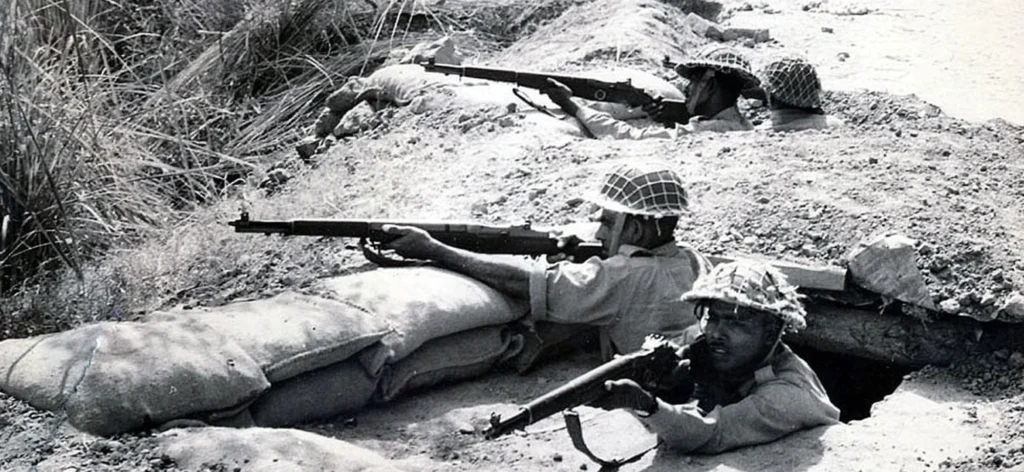September 6 stands in Pakistan’s history as a day of valor, sacrifice, and unity. It was on this day in 1965 that the Indian Army, without declaring war, crossed the international border under the cover of darkness, dreaming of breakfast in Lahore and raising glasses in the Gymkhana by evening. What they met instead was a wall of faith, steel, and firepower. Pakistan’s soldiers, shoulder to shoulder with a determined nation, shattered India’s arrogance and proved that wars are not only fought with weapons, they are won by spirit and love for the homeland.
From Sargodha to Dwarka, from the deserts of Rajasthan to the fertile plains of Punjab, the September War was written in courage. Among its most iconic chapters stands the Battle of Khem Karan, the deepest Pakistani thrust into Indian territory, and the second great tank battlefield between the two nations.
The Road to Khem Karan
The opening sparks of conflict came months earlier, in March 1965, with skirmishes in the Rann of Kutch. There, a regular infantry division of the Pakistan Army, supported by M-48 tanks, routed Indian border forces. By September, the confrontation had escalated. Indian troops, emboldened, struck unarmed Pakistani villages and launched a three-pronged offensive on Lahore, planning to seize the BRB Canal through the sector of Burki and Ruhi Nala.
India’s XI Corps, including the 4th Mountain Division, stood poised in the Bhikhiwind, Khem Karan area, with the grand design of advancing toward Lahore and Kasur. Pakistan’s response was swift and resolute: a counter-offensive across the Punjab sector aimed at severing Indian supply routes and forcing its retreat.
The Assault on Khem Karan Salient
On the night of September 7, 1965, Pakistan’s 1st Armoured Division and 11th Infantry Division launched their counter-attack in the Kasur sector. By September 8, Pakistani forces, spearheaded by the M-47 Patton tanks of the 6th Lancers and 24th Cavalry, breached Indian defenses and stormed into Khem Karan, barely five kilometers inside Indian territory.
Pakistani troops raised their flag there and removed Tiranga. They captured Customs House and took pictures at the Khem Karan milestone, powerful symbols of drowning India’s Gymkhana fantasies in the waters of the BRB Canal. Nearby, the village of Valtoha also fell, and Pakistani columns pushed further toward Asal Uttar.
Against Odds and Adversity
The battle was not without grave challenges. The odds piled high:
The makeshift bridges over the BRB Canal, which were to be used for the movement of troops, collapsed, and officers were martyred during crossings. The treacherous, marshy terrain of sugarcane fields, later deliberately flooded by Indian forces, was an odd but our troops maintained their nerves and valor.
At Asal Uttar, Pakistani armour encountered stiff resistance from Indian Centurion tanks, skillfully deployed in a horseshoe-shaped trap. Indian Command flooded the fields of sugarcane with water, turning it into marshy land. Here, the advantage tilted to India, costing Pakistan heavy tank losses. Yet, despite the setback, the town of Khem Karan itself remained firmly in Pakistan’s hands.
The Indian Counter and Pakistan’s Hold
India launched repeated attempts to retake Khem Karan. Each attack faltered. Even in the “dying hours of the war,” Indian efforts failed. Though Pakistan’s deeper thrust stalled at Asal Uttar, its possession of Khem Karan became a political and psychological victory, a stern reply to India’s boastful dreams of Gymkhana.
Stalemate and Diplomacy
By mid-September, the war settled into stalemate. On September 22, 1965, under United Nations Security Council orders and the pressure of both the United States and the Soviet Union, a ceasefire was declared. The fate of captured territories, including Khem Karan, was decided not on the battlefield but at the diplomatic table.
At the Tashkent Declaration (January 10, 1966), Pakistan and India agreed to withdraw to positions held prior to August 5, 1965. It was by this agreement, not by force, that Pakistan handed Khem Karan back to India.
Legacy of Khem Karan
The Khem Karan front remains etched in memory as one of grit, sacrifice, and indomitable spirit. It was the deepest Pakistani penetration into India across international borders, fought under the heaviest of odds. Its story invokes timeless images of bravery and loss, retold today in the bright, fleeting language of a digital age.
Wars are not merely fought with steel and fire, they are remembered through the spirit they inspire. Khem Karan is such a tale: where the dreams of Gymkhana fell, and where Pakistan’s faith and resolve carved a lasting mark on history.

